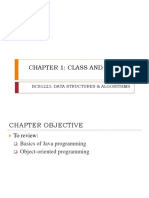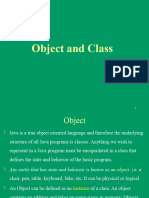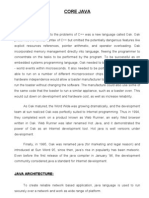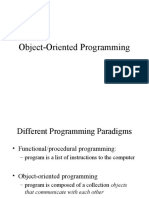Comments: / This Comment Is So Long That It Needs Two Lines
Uploaded by
Manish KjComments: / This Comment Is So Long That It Needs Two Lines
Uploaded by
Manish Kj26/03/2009
Comments
C-style comments (multi-lines)
/* this comment is so long that it needs two lines */
Java (basic concepts)
Comments on a single line
// comment on one line
Version 3 - March 2009
Politecnico di Torino
Code blocks and Scope
Java code blocks are the same as in C language Each block is enclosed by braces { } and starts a new scope for the variables Variables can be declared both at the beginning and in the middle of block code
for (int i=0; i<10; i++){ int x = 12; ... int y; ... }
Politecnico di Torino
Control statements
Same as C
if-else, switch, while, do-while, for, break, continue
Politecnico di Torino
Boolean
Java has an explicit type (boolean) to represent logic values (true, false) Conditional constructs evaluate boolean conditions
Note well - Its not possible to evaluate this condition int x = 7; if(x){} //NO Use relational operators if (x != 0)
Passing parameters
Parameters are always passed by value ...they can be primitive types or object references Note well: only the object reference is copied not the value of the object
Politecnico di Torino
Politecnico di Torino
26/03/2009
Constants
The final modifier
final float PI = 3.14; PI = 16.0; // ERROR, no changes final int SIZE; // ERROR, init missing
Elements in a OO program
Structural elements (types) (compile time) Class Primitive type Dynamic elements (data) (run time) Reference Variable
Use uppercases (coding conventions)
Politecnico di Torino
Politecnico di Torino
Classes and primitive types
descriptor Class class Exam {}
Primitive type
Defined in the language:
int, double, boolean
type primitive int, char, float Variable of type primitive int i;
Instance declaration:
Variable of type reference instance Exam e; e = new Exam();
Declares instance name 0 Declares the type Allocates memory space for the reference
int i;
Politecnico di Torino
Politecnico di Torino
10
Class
Defined by developer (eg, Exam) or by the Java environment (eg, String) the following declaration Exam e;
e null
allocates memory space for the reference (pointer) and sometimes it initializes it with null by default Allocation and initialization of the object value are made later by its constructor e = new Exam();
Politecnico di Torino
Primitive types
e 0Xffe1
Object Exam
11
26/03/2009
Primitive types
Have a unique dimension and encoding
Representation is platform-independent
Constants
Constants of type int, float, char, strings follow C syntax
123 256789L 0.12375e+3 a % 0xff34 123.75 prova\n \n prova
type
boolean char byte short int long float double void
Politecnico di Torino
Dimension
1 16 8 16 32 64 32 64 bit bits bits bits bits bits bits bits
Unicode Signed integer 2C Signed integer 2C Signed integer 2C Signed integer 2C IEEE 754 sp IEEE 754 dp
Encoding
Boolean constants (do not exist in C) are
true, false
13
Politecnico di Torino
14
Operators (integer and floating-point)
Operators follow C syntax:
arithmetical + - * / % relational == != > < >= <= bitwise (int) & | ^ << >> ~ Assignment = += -= *= /= %= &= |= ^= Increment ++ --
Logical operators
Logical operators follows C syntax:
&& || ! ^
Note well: Logical operators work ONLY on booleans
Type int is NOT considered a boolean value like in C Relational operators work with boolean values
Chars are considered like integers (e.g. switch)
Politecnico di Torino
15
Politecnico di Torino
16
Class
Object descriptor It consists of attributes and methods
Classes
Politecnico di Torino
18
26/03/2009
Class - definition
class Car { Name String color; Car String brand; Attributes boolean turnedOn; color void turnOn() { brand turnedOn = true; turnedOn } turnOn Methods void paint (String newCol) { paint color = newCol; printState } void printState () { System.out.println(Car + brand + + color); System.out.println(the engine is +(turnedOn:on:off)); } }
Politecnico di Torino
Methods
Methods are the messages that an object can accept
turnOn paint printState
Method may have parameters
paint(Red)
19
Politecnico di Torino
20
Overloading
In a Class there may be different methods with class Car { the same name String color; But they have a void paint(){ different signature color = white; A signature is made } by: void paint(int i){} Method name void paint(String Ordered list of newCol){ parameters types color = newCol; the method whose } parameters types list } matches, is then executed
Politecnico di Torino
Overloading
public class Foo{ public void doIt(int x, long c){ System.out.println("a"); } public void doIt(long x, int c){ System.out.println("b"); } public static void main(String args[]){ Foo f = new Foo(); f.doIt( 5 ,(long)7 ); // a f.doIt( (long)5 , 7 ); // b } }
21
Politecnico di Torino
22
Objects
An object is identified by:
Its class, which defines its structure (attributes and methods) Its state (attributes values) An internal unique identifier
Objects
class Car { String color; void paint(){ color = white; } void paint(String newCol) { color = newCol; } } Car a1, a2; a1 = new Car(); a1.paint(green); a2 = new Car();
23
Politecnico di Torino
Zero, one or more reference can point to the same object
Politecnico di Torino
24
26/03/2009
Objects and references
Car a1, a2; // a1 and a2 are uninitialized a1 = new Car(); a1.paint(yellow);// Car yellow generated, // a1 is a reference pointing to yellow a2 = a1; //now two references point to yellow a2 = null; // a reference points to yellow a1 = null;// no more references point to yellow // Object exists but it is no more reachable // then it will be freed by // the garbage collector
Objects Creation
Creation of an object is made with the keyword new It returns a reference to the piece of memory containing the created object
Motorcycle m = new Motorcycle();
Note Well: a reference IS NOT an object
Politecnico di Torino
25
Politecnico di Torino
26
The keyword new
Creates a new instance of the specific Class, and it allocates the necessary memory in the heap Calls the constructor method of the object (a method without return type and with the same name of the Class) Returns a reference to the new object created Constructor can have parameters
String s = new String(ABC);
Politecnico di Torino
Heap
It is a part of the memory used by an executing program to store data dynamically created at runtime C: malloc, calloc and free
Instances of types in static memory or in heap
Java: new
Instances (Objects) are always in the heap
27
Politecnico di Torino
28
Constructor
Constructor method contains operations (initialization of attributes etc.) we want to execute on each object as soon as it is created Attributes are always initialized
Attributes are initialized with default values
Constructors with overloading
class Window { String title; String color; Window() { // creates a window with no title and no color } Window(String t) { // creates a window with title but no color ... title = t; } Window(String t, String c) { // creates a window with title and color... title = t; color = c; }}
29
Politecnico di Torino
If a Constructor is not declared, a default one (with no parameters) is defined Overloading of constructors is often used
Politecnico di Torino
30
26/03/2009
Destruction of objects
It is no longer a programmer concern See section on Memory management Before the object is really destroyed if exists method finalize is invoked: public void finalize()
Methods invocation
A method is invoked using dotted notation
objectReference.Method(parameters)
Example:
Car a = new Car(); a.turnOn(); a.paint(Blue);
Politecnico di Torino
31
Politecnico di Torino
32
Caveat
If a method is invoked within another method of the same object
DO NOT need to use dotted notation
class Book { int pages; void readPage(int n) { } void readAll() { for (int i=0; i<pages; i++) readPage(i); } }
Caveat (contd)
In such cases this is implied this is a reference to the current object
class Book { int pages; void readPage(int n){} void readAll() { for() readPage(i); void readAll() { } for() } this.readPage(i); }
33 34
Politecnico di Torino
Politecnico di Torino
Access to attributes
Dotted notation
objectReference.attribute Reference is used like a normal variable
Car a = new Car(); a.color = Blue; //whats wrong here? boolean x = a.turnedOn;
Access to attributes
Methods accessing attributes of the same object do not need using object reference
class Car { String color; void paint(){ color = green; // color refers to current obj } }
Politecnico di Torino
35
Politecnico di Torino
36
26/03/2009
this
It can be useful in methods to distinguish object attributes from local variables
this represents a reference to the current object
Combining dotted notations
Dotted notations can be combined System.out.println(Hello world!);
System is a Class in package java.lang Out is a (static) attribute of System referencing an object of type PrintStream (representing the standard output) Println() is a method of PrintStream which prints a text line on the screen
class Car{ String color; ... void paint (String color) { this.color = color; } }
Politecnico di Torino
37
Politecnico di Torino
38
Operations on references
Only the relational operators == and != are defined
Note well: the equality condition is evaluated on the values of the references and NOT on the values of the objects ! The relational operators tell you whether the references points to the same object in memory
Strings
Dotted notation is applicable to object references There is NO pointer arithmetic
Politecnico di Torino
39
String
No primitive type to represent string String literal is a quoted text C
char s[] = literal Equivalence between string and char arrays
Operator +
It is used to concatenate 2 strings
This string + is made by two strings
Works also with other types (automatically converted to string)
System.out.println(pi = + 3.14); System.out.println(x = + x);
Java
char[] != String String class in java.lang library
Politecnico di Torino
41
Politecnico di Torino
43
26/03/2009
String
int length()
returns string length
String
String valueOf(int)
Converts int in a String available for all primitive types
boolean equals(String s)
compares the values of 2 strings
String s1, s2; s1 = new String(First string); s2 = new String(First string); System.out.println(s1); System.out.println(Length of s1 = + s1.length()); if (s1.equals(s2)) // true if (s1 == s2) // false
Politecnico di Torino
String toUpperCase() String toLowerCase() String concat(String str) - like + int compareTo(String str)
Compare w.r.t alphabetical order <0 if this < str ==0 if this == str >0 if this > str
44
Politecnico di Torino
45
String
String subString(int startIndex)
String s = Human; s.subString(2) returns man
StringBuffer
insert append delete reverse
String subString(int start, int end)
Char start included, end excluded String s = Greatest; s.subString(0,5) returns Great
int indexOf(String str)
Returns the index of the first occurrence of str
int lastIndexOf(String str)
The same as before but search starts from the end
Politecnico di Torino
46
Politecnico di Torino
47
Character
Utility methods on the kind of char
isLetter(), isDigit(), isSpaceChar()
Utility methods for conversions
toUpper(), toLower()
Scope and encapsulation
Politecnico di Torino
48
26/03/2009
Example
Laundry machine, design1
commands:
time, temperature, amount of soap
Example (contd)
Washing machine, design3
command:
Wash!
Different values depending if you wash cotton or wool, .
insert clothes, and the washing machine automatically select the correct program
Laundry machine, design2
commands:
key C for cotton, W for wool, Key D for knitted robes
Hence, there are different solutions with different level of granularity / abstraction
50
Politecnico di Torino
Politecnico di Torino
51
Motivation
Modularity = cut-down inter-components interaction Info hiding = identifying and delegating responsibilities to components
components = Classes interaction = read/write attributes interaction = calling a method
Scope and Syntax
private (applied to attribute or method)
attribute/method visible by instances of the same class
public
attribute / method visible everywhere
protected
attribute / method visible by instance of the same class and sub-classes
Heuristics
attributes invisible outside the Class Visible methods are the ones that can be invoked from outside the Class
Forth type (later)
Politecnico di Torino
52
Politecnico di Torino
53
Info hiding
class Car { public String color; } Car a = new Car(); a.color = white; // ok class Car { private String color; public void paint(String color) {this.color = color;} } Car a = new Car(); better a.color = white; // error a.paint(green); // ok
Politecnico di Torino
Info hiding
class Car{ private String color; public void paint(); no }
yes
class B { public void f1(){ ... }; }
54
Politecnico di Torino
55
26/03/2009
Access
Method in the same class Private (attribute/ method) Public yes Method of another class no
Getters and setters
Methods used to read/write a private attribute Allow to better control in a single point each write access to a private field
public String getColor() { return color; } public void setColor(String newColor) { color = newColor; }
56
Politecnico di Torino
yes
yes
Politecnico di Torino
57
Example without getter/setter
public class Student {
public public public public String first; String last; int id; Student(){}
Example without getter/setter
class StudentExample { public static void main(String[] args) { // defines a student and her exams // lists all students exams Student s=new Student(Alice",Green",1234); Exam e = new Exam(30); e.student = s; // print vote System.out.println(e.grade); // print student System.out.println(e.student.last); } }
58
Politecnico di Torino
} public class Exam {
public int grade; public Student student; public Exam(){}
}
Politecnico di Torino
59
Example with getter/setter
class StudentExample { public static void main(String[] args) { Student s = new Student(Alice, Green, 1234); Exam e = new Exam(30); e.setStudent(s); // prints its values and asks students to // print their data e.print(); } }
Politecnico di Torino
Example with getter/setter
public class Student { private String first; private String last; private int id; public String toString() { return first + " " + last + " " + id; } }
60
Politecnico di Torino
61
10
26/03/2009
Example with getter/setter
public class Exam { private int grade; private Student student; public void print() { System.out.println(Student + student.toString() + got + grade); } public void setStudent(Student s) { this.student =s; } }
62
Array
Politecnico di Torino
Array
An array is an ordered sequence of variables of the same type which are accessed through an index Can contain both primitive types or object references (but no object values) Array dimension can be defined at run-time, during object creation (cannot change afterwards)
Politecnico di Torino
Array declaration
An array reference can be declared with one of these equivalent syntaxes
int[] a; int a[];
In Java an array is an Object and it is stored in the heap Array declaration allocates memory space for a reference, whose default value is null
a null
65 64
Politecnico di Torino
Array creation
Using the new operator
int[] a; a = new int[10]; String[] s = new String[5];
Example - primitive types
int[] a;
a null heap
or using static initialization, filling the array with values
int[] primes = {2,3,5,7,11,13}; Person[] p = { new Person(John), new Person(Susan) };
a = new int[6];
heap
0 0 0 0 0 0
int[] primes = {2,3,5,7,11,13};
66
Politecnico di Torino
primes
heap
2 3 5 7 11 13 67
Politecnico di Torino
11
26/03/2009
Example - object references
String[] s = new String[6]; s[1] = new String(abcd); Person[] p = {new Person(John) , new Person(Susan)};
Politecnico di Torino
Operations on arrays
Elements are selected with brackets [ ] (C-like)
But Java makes bounds checking
heap
null null null null null null
heap
null null null null null
abcd
Array length (number of elements) is given by attribute length
for (int i=0; i < a.length; i++) a[i] = i;
heap
John Susan
68
Politecnico di Torino
69
Operations on arrays
An array reference is not a pointer to the first element of the array It is a pointer to the array object
For each
New loop construct:
for( Type var : set_expression ) Notation very compact set_expression can be
either an array a class implementing Iterable
Arithmetic on pointers does not exist in Java
The compiler can generate automatically loop with correct indexes Thus less error prone
70
Politecnico di Torino
Politecnico di Torino
71
For each - example
Example:
for(String arg: args){ //... } is equivalent to for(int i=0; i<args.length;++i){ String arg= args[i]; //... }
Politecnico di Torino
Homework
Create an object representing an ordered list of integer numbers (at most 100) print()
prints current list
add(int) and add(int[])
Adds the new number(s) to the list
72
Politecnico di Torino
73
12
26/03/2009
Multidimensional array
Implemented as array of arrays
Person[][] table = new Person[2][3]; table[0][2] = new Person(Mary);
Rows and columns
As rows are not stored in adjacent positions in memory they can be easily exchanged
double[][] balance = new double[5][6]; ... double[] temp = balance[i]; balance[i] = balance[j]; balance[j] = temp;
table
heap
null null null null null
table[0][2]
Mary
table[0]
Politecnico di Torino
74
Politecnico di Torino
75
Rows with different length
A matrix (bidimen-sional array) is indeed an array of arrays
int[][] triangle = new int[3][]
triangle
null null null
Tartaglias triangle
Write an application printing out the following Tartaglias triangle 1 1 1 1 2 1 4=3+1 1 3 3 1 1 4 6 4 1 1 5 10 10 5 1 1 6 15 20 15 6 1
76
Politecnico di Torino
heap
for (int i=0; i< triangle.length; i++) triangle[i] = new int[i+1];
triangle
0 0 0 0
Politecnico di Torino
0 0
77
Motivation
Class is a better element of modularization than a procedure But it is still little For the sake of organization, Java provides the package feature
Package
Politecnico di Torino
79
13
26/03/2009
Package
A package is a logic set of class definitions These classes are made of several files, all stored in the same directory Each package defines a new scope (i.e., it puts bounds to visibility of names) Its then possible to use same class names in different package without name-conflicts
Package name
A package is identified by a name with a hierarchic structure (fully qualified name)
E.g. java.lang (String, System, )
Conventions to create unique names
Internet name in reverse order it.polito.myPackage
Politecnico di Torino
80
Politecnico di Torino
81
Example
java.awt
Window Button Menu
Creation and usage
Creation:
Package statement at the beginning of each class file
package packageName;
Usage:
Import statement at the beginning of class file (where needed) Import
import packageName.className; import java.awt.*; Import all
classes but not the sub packages single class (class name is in scope)
java.awt.event (sub-package)
MouseEvent KeyEvent
Politecnico di Torino
82
Politecnico di Torino
83
Access to a class in a package
Referring to a method/class of a package
int i = myPackage.Console.readInt()
Package and scope
Scope rules also apply to packages The interface of a package is the set of public classes contained in the package Hints
Consider a package as an entity of modularization Minimize the number of classes, attributes, methods visible outside the package
If two packages define a class with the same name, they cannot be both imported If you need both classes you have to use one of them with its fully-qualified name:
import java.sql.Date; Date d1; // java.sql.Date java.util.Date d2 = new java.util.Date();
Politecnico di Torino
84
Politecnico di Torino
85
14
26/03/2009
Package visibility
Package P class A { public int a1; private int a2; public void f1(){} }
yes no
Visibility w/ multiple packages
public class A { }
Public methods/attributes of A are visible outside the package
class B { public int a3; private int a4; }
class B { }
No method/attribute of B is visible outside the package
Politecnico di Torino
86
Politecnico di Torino
87
Multiple packages
Package P class A { public int a1; private int a2; public void f1(){} } class B { public int a3; private int a4; }
Multiple packages
Package P public class A { public int a1; private int a2; public void f1(){} } class B { public int a3; private int a4; }
no
no
yes
no
Package Q class C { public void f2(){} }
Package Q class C { public void f2(){} }
Politecnico di Torino
88
Politecnico di Torino
89
Access rules
Method in the same class Private attribute/ method Yes Method of other Method of other class in the same class in other package package No Yes Yes No No No
Package attribute / Yes method Public attribute / method on package class Public attribute / method on public class Yes
Static attributes and methods
Yes
Yes
Yes
Politecnico di Torino
90
15
26/03/2009
Class variables
Represent properties which are common to all instances of an object But they exist even when no object has been instantiated They are defined with the static modifier Access: ClassName.attribute
class Car { static int numberOfWheels = 4; } int y = Car.numberOfWheels;
Politecnico di Torino
Static methods
Static methods are not related to any instance They are defined with the static modifier Access: ClassName.method()
class HelloWorld { public static void main (String args[]) { System.out.println(Hello World!); } } double y = Math.cos(x); // static method
92 93
Politecnico di Torino
Enum
Defines an enumerative type
public enum Suits { SPADES, HEARTS, DIAMONDS, CLUBS } Suits card = Suits.HEARTS;
Enum
Enum can be declared outside or inside a class, but NOT within a method Enums are not Strings or ints, but more like a kind of class but constructor cant be invoked directly, conceptually like this:
class Suits { public static final Suits HEARTS= new Suits (HEARTS,0); public static final Suits DIAMONDS= new Suits (DIAMONDS,1); public static final Suits CLUBS= new Suits (CLUBS, 2); public static final Suits SPADES= new Suits (SPADES, 3); public Suits (String enumName, int index) {} }
94 95
Variables of enum types can assume only one of the enumerated values They allow much more strict static checking compared to integer constants (used e.g. in C)
Politecnico di Torino
Politecnico di Torino
Motivation Wrapper classes for built-in types
In an ideal OO world, there are only classes and objects For the sake of efficiency, Java use primitive types (int, float, etc.) Wrapper classes are object versions of the primitive types They define conversion operations between different types
Politecnico di Torino
97
16
26/03/2009
Wrapper Classes
Defined in java.lang package Primitive type
boolean char byte short int long float double void
Politecnico di Torino
Conversions
Wrapper Class
Boolean Character Byte Short Integer Long Float Double Void
98
Integer
intValue()
new Integer(i)
toString()
Integer.valueOf(s) new Integer(33)
iint
String
Integer.parseInt(33) String.valueOf(33) +
Politecnico di Torino
99
Example
Integer obj = new Integer(88); String s = obj.toString(); int i = obj.intValue();
Autoboxing
In Java 5 an automatic conversion between primitive types and wrapper classes (autoboxing) is performed.
Integer i= new Integer(2); int j; j = i + 5; //instead of: j = i.intValue()+5; i = j + 2; //instead of: i = new Integer(j+2);
100
Politecnico di Torino
int j = Integer.parseInt(99); int k = (new Integer(99)).intValue();
Politecnico di Torino
101
Variable arguments
It is possible to pass a variable number of arguments to a method using the varargs notation method( Object ... args ) The compiler assembles an Object array that can be used to scan the passed parameters
Variable arguments - example
static void plst(String pre, Object...args){ System.out.print(pre); for(Object o:args){ if(o!=args[0]) System.out.print(", "); System.out.print(o); } System.out.println(); } public static void main(String[] args) { plst("List:","A",'b',123, ciao); }
Politecnico di Torino
102
Politecnico di Torino
103
17
26/03/2009
Memory types
Depending on the kind of elements they include: Static memory
elements living for all the execution of a program (class definitions, static variables)
Memory management
Heap (dynamic memory)
elements created at run-time (with new)
Stack
elements created in a code block (local variables and method parameters)
Politecnico di Torino
105
Objects are stored in the heap
heap
Object
Types of variables
Instance variables (or fields or attributes)
Stored within objects (in the heap)
code
reference
State
Local Variables
Stored in the Stack
Static Variables
Stored in static memory
Politecnico di Torino
106
Politecnico di Torino
107
Instance Variables
Declared within a Class (attributes)
Class Window { boolean visible;
Window1 visible Window2 visible
Local Variables
Declared within a method or a code block Stored in the stack Created at the beginning of the code block where they are declared Automatically destroyed at the end of the code block
Class Window { void resize () { int i; for (i=0; i<5; i++) { } } // here i is destroyed
heap
There is a different copy in each instance of the Class Create/initialized whenever a new instance of a Class is created
Politecnico di Torino
108
Politecnico di Torino
109
18
26/03/2009
Static Variables
Declared in classes or methods with static modifier
Static variables in memory
Static area
Class ColorWindow { static String color;
ColorWindow
heap
ColorWindow1 ColorWindow2
color
Only ONE copy is stored in static memory
associated to a Class => also called Class variables
Created/initialized during Class-loading in memory
Politecnico di Torino
110
Politecnico di Torino
111
Object destruction
Its not made explicitely but it is made by the JVM when there are no more references to the object
Programmer must not worry about objects destruction
Garbage collector
Is a component of the JVM that has to clean heap memory from dead objects After a period of time it analyzes references and objects in memory ...and then it deallocates objects with no active references
Politecnico di Torino
112
Politecnico di Torino
113
19
You might also like
- CS8392 OBJECT ORIENTED PROGRAMMING Unit1No ratings yetCS8392 OBJECT ORIENTED PROGRAMMING Unit1221 pages
- Unit1-Unit9 AP计算机科学A模拟题笔记-AP Computer Science Practice笔记No ratings yetUnit1-Unit9 AP计算机科学A模拟题笔记-AP Computer Science Practice笔记34 pages
- 95712C Lecture Notes Wednesday, September 15, 2004: Objects and ClassesNo ratings yet95712C Lecture Notes Wednesday, September 15, 2004: Objects and Classes7 pages
- Java Programming - Day 1: Long Cycle - JEENo ratings yetJava Programming - Day 1: Long Cycle - JEE65 pages
- Presentation Overview of Java 1504807251 299177No ratings yetPresentation Overview of Java 1504807251 29917744 pages
- Unit 1 Partb: 1.explain OOP Principles. ClassNo ratings yetUnit 1 Partb: 1.explain OOP Principles. Class22 pages
- Object Oriented Programming Classes and Objects Updated 2021 5No ratings yetObject Oriented Programming Classes and Objects Updated 2021 564 pages
- Topic 2 - Java Programming Basics (Part 1)No ratings yetTopic 2 - Java Programming Basics (Part 1)51 pages
- Object Oriented Programming: Introduction To100% (1)Object Oriented Programming: Introduction To40 pages
- Object-Oriented Programming: Classes Object Creation and Destruction EqualityNo ratings yetObject-Oriented Programming: Classes Object Creation and Destruction Equality24 pages
- Kotlin Fast Track Guide - 86 Key Points Every Programmer from Other Languages Should MasterFrom EverandKotlin Fast Track Guide - 86 Key Points Every Programmer from Other Languages Should MasterNo ratings yet
- Introduction To UNIX Commands and Scripting: 0.0 Getting Help On-Line ManualsNo ratings yetIntroduction To UNIX Commands and Scripting: 0.0 Getting Help On-Line Manuals18 pages
- IT340 - Programming Language Design Concepts3No ratings yetIT340 - Programming Language Design Concepts35 pages
- Informatica PowerCenter Data Validation OptionNo ratings yetInformatica PowerCenter Data Validation Option2 pages
- Abap Alv Block - List Display With Total & Grand-TotalNo ratings yetAbap Alv Block - List Display With Total & Grand-Total18 pages
- Download ebooks file (Ebook) EJB 3.1 Cookbook by M. Reese, Richard ISBN 9781849682381, 1849682380 all chapters100% (9)Download ebooks file (Ebook) EJB 3.1 Cookbook by M. Reese, Richard ISBN 9781849682381, 1849682380 all chapters67 pages
- INTERMEDIATE CODE GENERATION & RUNTIME ENVIRNOMENTSNo ratings yetINTERMEDIATE CODE GENERATION & RUNTIME ENVIRNOMENTS35 pages
- CNCF Webinar February 27th From Notebook To Kubeflow Pipelines With MiniKF Kale 1No ratings yetCNCF Webinar February 27th From Notebook To Kubeflow Pipelines With MiniKF Kale 137 pages
- EX - NO 10 Simulation of Error Correction Code (CRC) Aim100% (1)EX - NO 10 Simulation of Error Correction Code (CRC) Aim4 pages
- Unit1-Unit9 AP计算机科学A模拟题笔记-AP Computer Science Practice笔记Unit1-Unit9 AP计算机科学A模拟题笔记-AP Computer Science Practice笔记
- 95712C Lecture Notes Wednesday, September 15, 2004: Objects and Classes95712C Lecture Notes Wednesday, September 15, 2004: Objects and Classes
- Object Oriented Programming Classes and Objects Updated 2021 5Object Oriented Programming Classes and Objects Updated 2021 5
- Object-Oriented Programming: Classes Object Creation and Destruction EqualityObject-Oriented Programming: Classes Object Creation and Destruction Equality
- Kotlin Fast Track Guide - 86 Key Points Every Programmer from Other Languages Should MasterFrom EverandKotlin Fast Track Guide - 86 Key Points Every Programmer from Other Languages Should Master
- Introduction To UNIX Commands and Scripting: 0.0 Getting Help On-Line ManualsIntroduction To UNIX Commands and Scripting: 0.0 Getting Help On-Line Manuals
- Abap Alv Block - List Display With Total & Grand-TotalAbap Alv Block - List Display With Total & Grand-Total
- Download ebooks file (Ebook) EJB 3.1 Cookbook by M. Reese, Richard ISBN 9781849682381, 1849682380 all chaptersDownload ebooks file (Ebook) EJB 3.1 Cookbook by M. Reese, Richard ISBN 9781849682381, 1849682380 all chapters
- INTERMEDIATE CODE GENERATION & RUNTIME ENVIRNOMENTSINTERMEDIATE CODE GENERATION & RUNTIME ENVIRNOMENTS
- CNCF Webinar February 27th From Notebook To Kubeflow Pipelines With MiniKF Kale 1CNCF Webinar February 27th From Notebook To Kubeflow Pipelines With MiniKF Kale 1
- EX - NO 10 Simulation of Error Correction Code (CRC) AimEX - NO 10 Simulation of Error Correction Code (CRC) Aim

























































































